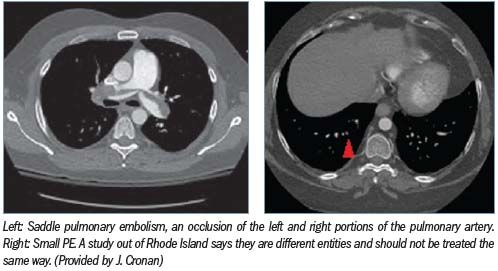Small pulmonary emboli still stump radiologists
Nearly two years after a paper titled “Dots are not clots: the over-diagnosis and over-treatment of pulmonary embolism” was presented at the RSNA meeting, radiologists are still debating when to put patients on anticoagulation therapy.
Nearly two years after a paper titled “Dots are not clots: the over-diagnosis and over-treatment of pulmonary embolism” was presented at the RSNA meeting, radiologists are still debating when to put patients on anticoagulation therapy. Some say it depends on the size of the clots as well as their location. Others say if a patient has any evidence of pulmonary embolism, anticoagulation therapy should be provided regardless.
Advances in CT allow radiologists to detect smaller and smaller pulmonary embolism (PE), but some clots occur naturally and don’t need to be disturbed, according to the paper, which was published recently in Emergency Radiology.
Incidental PE is detected in 1% to 5.7% of patients undergoing contrast-enhanced multislice CT of the chest for various clinical indications. This suggests physicians are diagnosing PE previously undetected by ventilation/perfusion scintigraphy or single-detector spiral CT, according to the study.
The 64-slice scanner detects very small clots that physicians never saw before, said Dr. John Cronan, radiologist in chief at Rhode Island Hospital in Providence and one of the study’s authors.

“The amount of PE in the population, if you call those little dots PE, is skyrocketing,” he said. “Yet there’s no indication more people are dying from PE, it’s just we’re seeing subclinical disease that existed before [and] had no clinical impact on the patient. Now we’re finding it.”
Physicians were perhaps better served not knowing small PE exists, because now they’re wont to treat it, he said.
Not all PE are abnormal, and small peripheral PE are a function of life, he said. Most radiologists report any filling defect, independent of size, as clinically significant when detected in the pulmonary arteries. Small dots in the pulmonary arteries are not clinically significant clots in the conventional setting, he said.
In their retrospective study, Cronan and colleagues included 1273 consecutive CT studies performed at Brown University, 101 (79%) of which were positive. Fifty patients had a lower extremity venous ultrasound performed within seven days of CT.
In 33 patients, an extensive clot load was detected in the central pulmonary arteries and termed classic PE. More than half (58%) had deep vein thrombosis and all received anticoagulation treatment.
In 17 patients, small clots (dots) were found in the peripheral pulmonary arteries (segmental, subsegmental, and distal fifth-order branches), with an average width of 2.5 mm. None of the patients had deep vein thrombosis and 88% received anticoagulation treatment.
Dots were not associated with detectable clot load in the lower extremities, which suggests the passing of small clots from the lower extremity valves to the lungs is a physiologic process with the lung capillary beds trapping and dissolving the emboli by endogenous fibrinolysis, thereby protecting the systemic circulation, the authors said.
“We believe that dots may represent normal embolic activity originating from the lower extremity venous valves,” the authors said.
Since the paper was presented nearly two years ago, the protocol at Rhode Island Hospital has changed.
“Our doctors will not give anticoagulation to patients who have one or two dots,” Cronan said. “They get a venous ultrasound of the leg and if there’s no clot in the leg, the doctors don’t anticoagulate.”
Not everyone is sure the study proves patients with small emboli do not require anticoagulation therapy.
“The study is one of many that has indirectly addressed the issue, since a controlled study in a large cohort of untreated patients with dots has not been performed,” said Drs. Lawrence Goodman and Kaushik Shahir, experts in PE and radiologists at the Medical College of Wisconsin in Milwaukee. “The majority of ‘dots patients’ were anticoagulated, so the authors did not prove the benign nature of dots. They did, however, add more circumstantial evidence that patients with small emboli and no deep vein thrombosis may not need to be anticoagulated.”
Radiologists are still pondering where to draw the line.
“Do you treat one dot? Two?” Cronan said.
As always, more studies are needed to answer that question.
Emerging AI Algorithm Shows Promise for Abbreviated Breast MRI in Multicenter Study
April 25th 2025An artificial intelligence algorithm for dynamic contrast-enhanced breast MRI offered a 93.9 percent AUC for breast cancer detection, and a 92.3 percent sensitivity in BI-RADS 3 cases, according to new research presented at the Society for Breast Imaging (SBI) conference.
The Reading Room Podcast: Current Perspectives on the Updated Appropriate Use Criteria for Brain PET
March 18th 2025In a new podcast, Satoshi Minoshima, M.D., Ph.D., and James Williams, Ph.D., share their insights on the recently updated appropriate use criteria for amyloid PET and tau PET in patients with mild cognitive impairment.
Can Abbreviated Breast MRI Have an Impact in Assessing Post-Neoadjuvant Chemotherapy Response?
April 24th 2025New research presented at the Society for Breast Imaging (SBI) conference suggests that abbreviated MRI is comparable to full MRI in assessing pathologic complete response to neoadjuvant chemotherapy for breast cancer.
Clarius Mobile Health Unveils Anterior Knee Feature for Handheld Ultrasound
April 23rd 2025The T-Mode Anterior Knee feature reportedly offers a combination of automated segmentation and real-time conversion of grayscale ultrasound images into color-coded visuals that bolster understanding for novice ultrasound users.